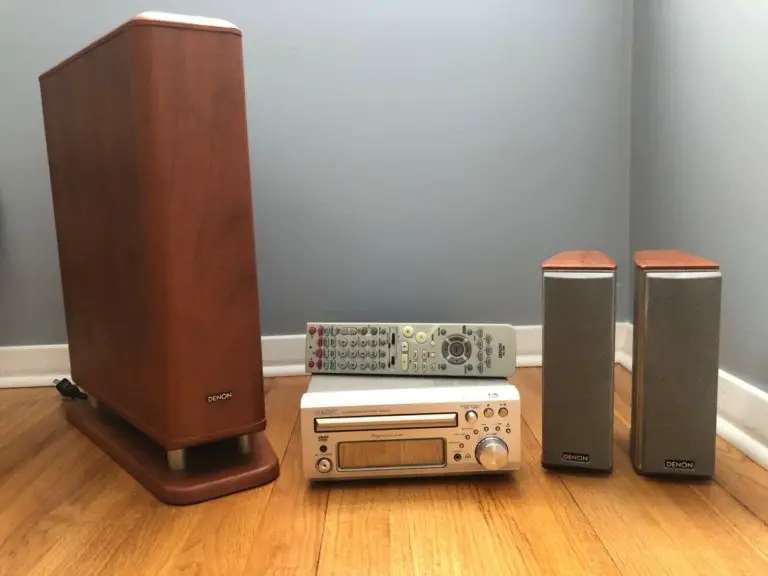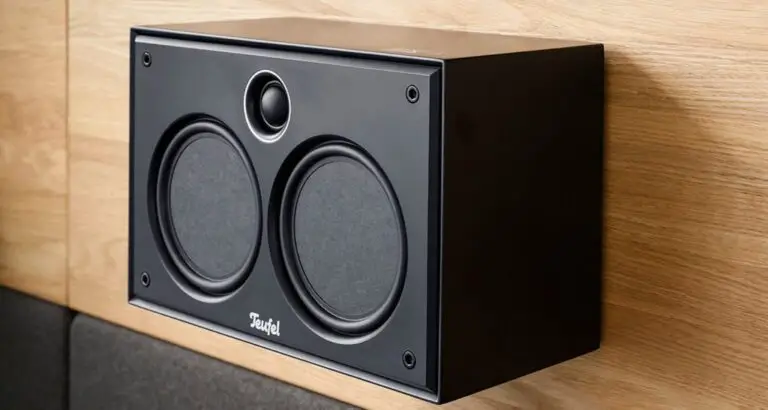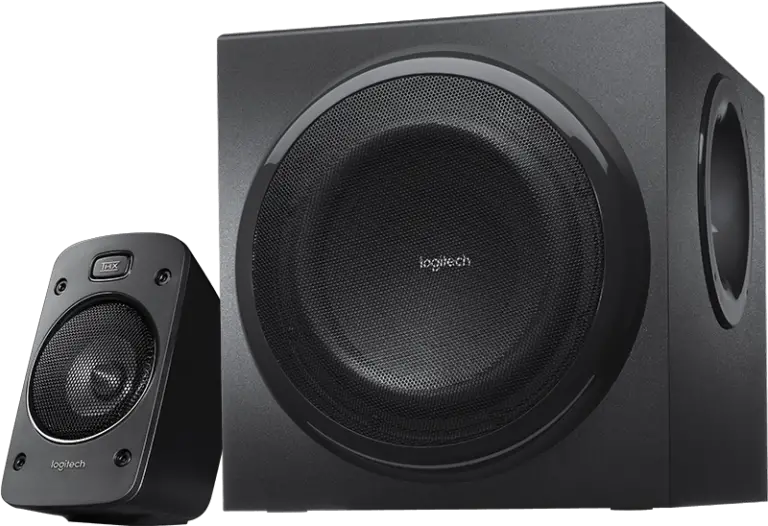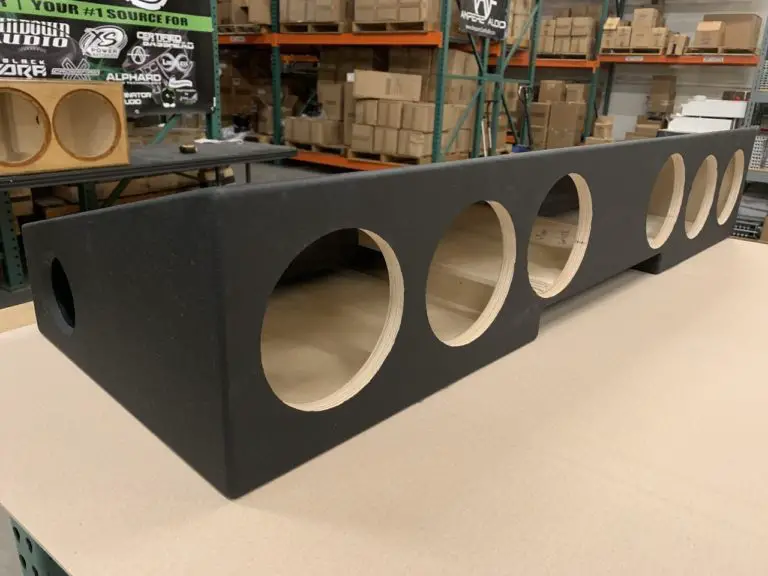If you’re looking to enhance your audio experience, look no further than a subwoofer. These specialized loudspeakers are designed to reproduce low-pitched audio frequencies, commonly referred to as bass and sub-bass. By focusing on these frequencies, subwoofers can create a deeper, richer sound experience that truly brings music and movies to life.
Subwoofers are a valuable addition to any audio setup, as they take over the task of reproducing bass frequencies, allowing the other speakers to focus on mid-range and high-range sounds.
This not only bolsters the audio output with powerful, thumping bass but also improves the overall sound clarity and dynamics. The integration of a subwoofer can significantly enhance the performance of your audio system, be it a home theater or a high-quality sound system for music.
Key Takeaways
- Subwoofers are specialized loudspeakers designed to reproduce low-pitched audio frequencies, commonly referred to as bass and sub-bass.
- Subwoofers can create a deeper, richer sound experience that truly brings music and movies to life.
- The integration of a subwoofer can significantly enhance the performance of your audio system.
Table of Contents
Types of Subwoofers
When it comes to improving your audio experience, subwoofers are a must-have component. They are designed to reproduce low frequencies, providing deep bass and enhanced sound quality. There are two main types of subwoofers: active and passive.
Active Subwoofers

Active subwoofers, also known as powered subwoofers, are self-contained units that include speakers and amplifiers. This means they have their own AC power source. These subwoofers are beneficial because they have dedicated amplifiers that are specifically designed to work with the subwoofer’s driver. As a result, they provide a more accurate and powerful bass response.
Active subwoofers are generally easier to set up because you don’t need to worry about matching the amplifier power with the driver’s requirements. They can also relieve some of the strain from your main amplifier or receiver since they handle their own power requirements.
However, active subwoofers tend to be larger and heavier due to their built-in amplifiers. Additionally, they may consume more electricity since they require a separate power source.
Passive Subwoofers
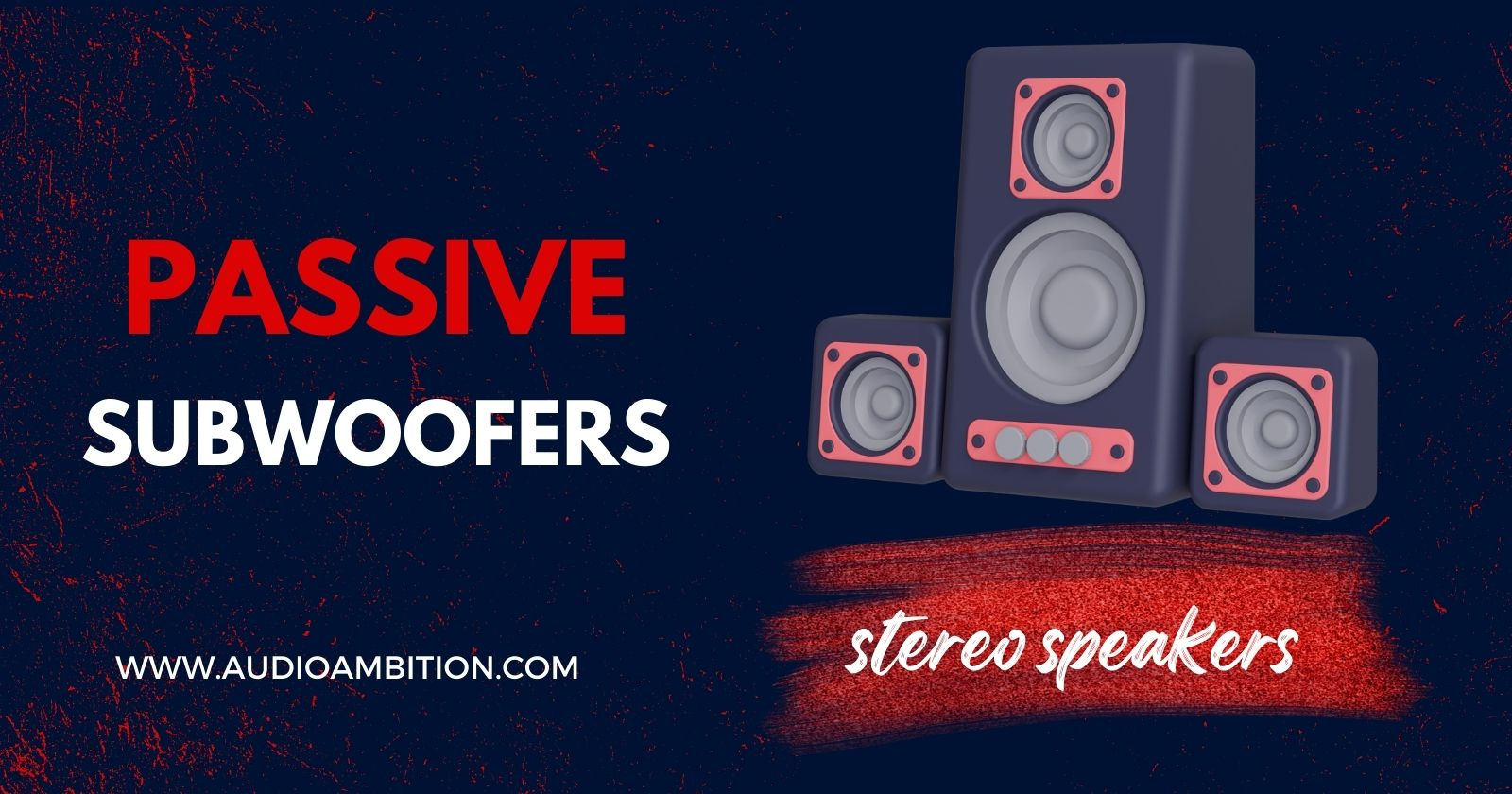
Passive subwoofers, on the other hand, rely on external amplification to function. They are often used in combination with other stereo speakers and integrated with your existing audio equipment.
To set up a passive subwoofer, you will need to match the power output of your amplifier or receiver to the subwoofer’s input power, ensuring that it can effectively produce the low-frequency sounds. While this setup might be more challenging, it offers greater customization and flexibility, allowing you to choose the best amplifier and subwoofer combination to suit your needs.
Passive subwoofers often have a smaller footprint since they do not contain built-in amplifiers. However, they may require more research and planning to ensure optimal sound quality and compatibility with your existing audio system.
Both passive and active subwoofers have their unique benefits, and your choice will largely depend on your specific requirements and preferences. Active subwoofers are ready-to-use, convenient options, while passive subwoofers allow for greater customization and flexibility.
To get the best audio experience, carefully consider which type of subwoofer best fits your needs and priorities.
Related Posts:
Components and Design

Enclosure
The enclosure is a vital component in a subwoofer that plays a significant role in producing bass frequencies. It is a box that houses the subwoofer speaker and comes in two types: sealed and vented.
Sealed enclosures are airtight and produce tight, accurate bass, while vented enclosures have a port or vent that allows air to move in and out of the cabinet, resulting in more efficient output and louder bass.
Cabinet
The cabinet is the outer shell or frame of the subwoofer that provides support and structure to the other components. It is typically made of materials such as medium-density fiberboard (MDF), plywood, or plastic.
MDF and plywood provide a balance between weight, strength, and affordability, while more premium cabinets may use plastic or aluminum for a more lightweight and visually appealing design.
Driver and Voice Coil
The driver is the actual speaker component responsible for producing sound in a subwoofer. It is made up of several key components, including the diaphragm, magnet, and voice coil. The diaphragm is a cone-shaped membrane, usually made from paper, plastic, or metal, that moves back and forth to produce sound waves.
The voice coil is a wire coil mounted behind the diaphragm and connected to an external amplifier. When an electric current from the amplifier passes through the voice coil, it creates a magnetic field that interacts with the permanent magnet, causing the diaphragm to move and produce sound.
Suspension
The suspension system in a subwoofer keeps the driver centered within the cabinet during movement. It consists of two primary components: the spider and the surround. The spider connects the voice coil to the basket, allowing the diaphragm to move back and forth while maintaining control and stability.
The surround is the flexible rim around the diaphragm, made from rubber, foam, or cloth, which helps to keep the diaphragm centered and ensures a good seal between the driver and the cabinet.
Port or Vent
In vented or ported subwoofers, the port or vent is a crucial feature that helps improve efficiency and provide louder bass output. By allowing air to move in and out of the cabinet, the port reduces the pressure inside the enclosure and lessens the resistance on the diaphragm.
The size and shape of the port or vent can significantly impact the subwoofer’s performance and frequency response.
Related Posts:
Frequency and Response

Frequency Range
A subwoofer is a type of loudspeaker that reproduces low frequencies, typically ranging from 20 Hz to 200 Hz for consumer products. The range of human hearing is generally regarded as being from 20 Hz (very low bass tones) to 20 kHz (very high treble).
Subwoofers complement an audio system composed of mains and satellite speakers by filling in the difficult-to-reproduce bass region in the desired frequency spectrum.
Frequency Response
Frequency response refers to the manner in which a specific audio component reproduces audible frequencies and whether it makes any changes to the signal when passing the lowest frequencies through.
It is measured in Hertz and evaluates the performance of a subwoofer in producing low-end frequencies. A good subwoofer should have a frequency response range that can handle low frequencies efficiently. For example, an ideal subwoofer rating could be 20 Hz to 120 Hz.
Crossover Point
The crossover point is an essential aspect of a subwoofer’s performance, as it determines the highest frequency the subwoofer will reproduce before passing on the higher frequencies to the main or satellite speakers.
Typically, the crossover point of an active subwoofer is set within the range of 80 Hz to 150 Hz. This ensures a seamless blend between the subwoofer and the main speakers, providing a balanced audio experience for the listener.
Understanding the frequency range, frequency response, and the crossover point is crucial in selecting the best subwoofer for your audio system. A subwoofer enhances the listener’s audio experience by reproducing low frequencies that might be difficult for the main or satellite speakers to handle.
Subwoofer Placement and Size
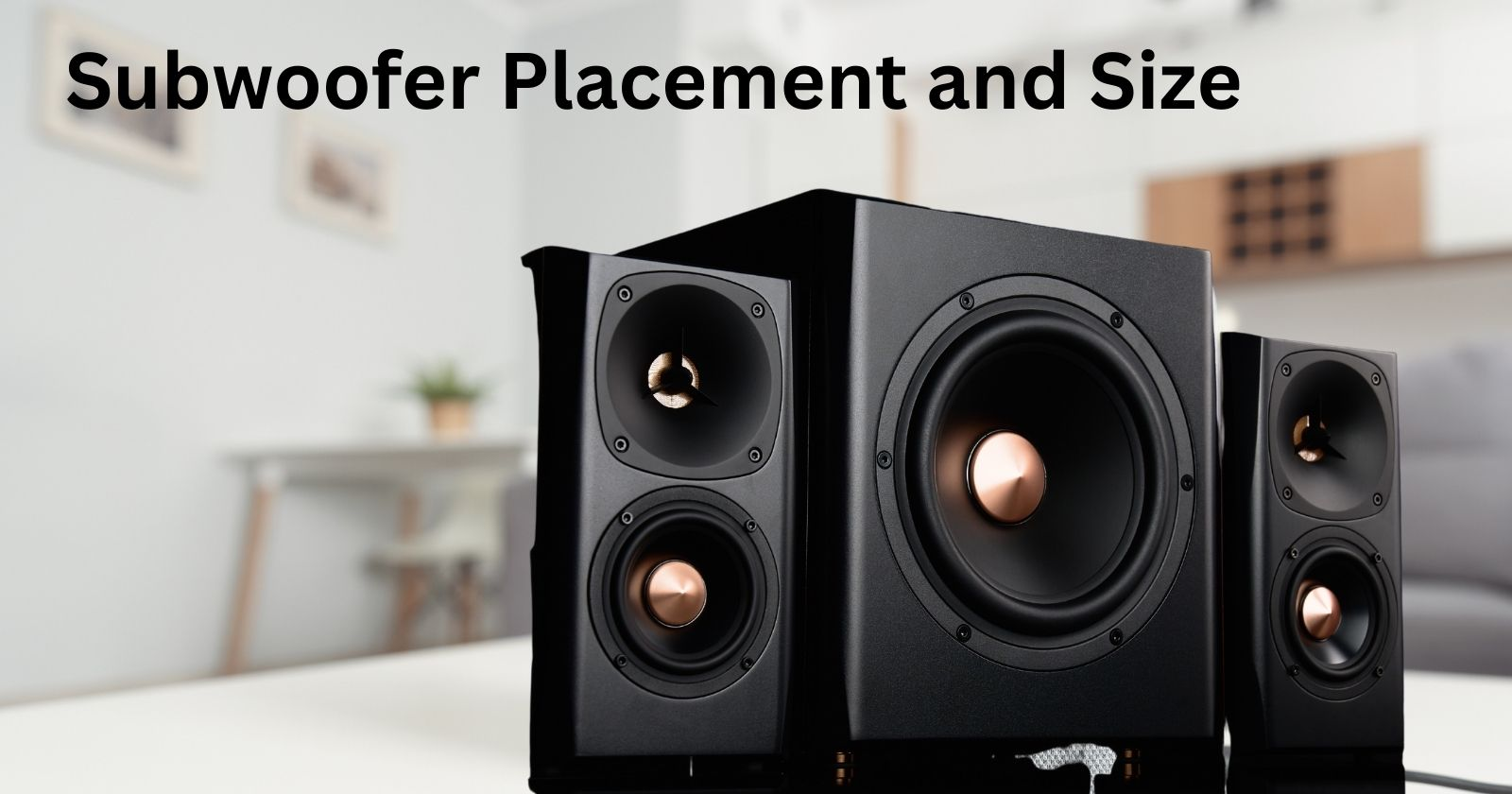
Room Size and Standing Waves
When setting up your subwoofer, it’s important to take into account the size of the room and the potential for standing waves. Standing waves occur when sound waves bounce off walls and interfere with each other, resulting in areas of overly intense or weak bass.
To achieve optimal sound, choose a subwoofer whose size complements the dimensions of your room. Larger rooms may require a bigger subwoofer with more power, while smaller rooms may benefit from a more compact and less powerful unit.
Placement Options
There are several placement options to achieve the best sound from your subwoofer. One technique is the crawling method, which involves placing the subwoofer in the listening position and crawling around the room to find the sweet spot where it sounds best.
Another option is to consider an elevated position, such as on a sturdy table, cabinet, or mounted on the wall. This can help distribute the bass more evenly throughout the room.
For subwoofers with larger drivers and more powerful amps, it’s generally recommended to pull them at least 8 to 12 inches from any wall for the best results. If your subwoofer is a ported design, make sure it’s twice the diameter of the port (typically 6-12 inches) away from a wall to allow proper airflow.
Using multiple subwoofers can also help evenly distribute bass frequencies throughout the room, creating a thick sound for a more immersive listening experience.
Trial and Error
Finding the perfect subwoofer placement in your room may require some trial and error. Experiment with different subwoofer locations and listen to various types of music and audio to identify areas in the room where the bass response is either too strong or too weak.
Pay attention to your room’s unique acoustics, and be prepared to make adjustments based on listening tests. Don’t be afraid to change the subwoofer’s orientation or adjust the crossover and phase controls to fine-tune your system’s performance. Remember, it’s always a good idea to experiment and trust your ears when setting up your subwoofer.
Integration with Audio Systems

If you want to enhance your audio experience, integrating a subwoofer into your audio system can make a significant difference. This section will provide you with the necessary information on how to integrate a subwoofer into your home theater, stereo, or car stereo system.
Home Theater Systems
A subwoofer is an essential component of any home theater system. The subwoofer reproduces low-frequency sound waves that are crucial for creating an immersive audio environment while watching movies or playing games.
Here are some tips to integrate a subwoofer into your home theater system:
- Placement: Position your subwoofer in a corner of the room for the best bass response. Avoid placing it too close to the wall or furniture to prevent reflecting sound waves.
- Connection: Use a subwoofer cable to connect the receiver’s subwoofer output to the subwoofer input.
- Settings: Configure your receiver to manage the frequency distribution between the speakers and subwoofer correctly. Generally, the crossover frequency is set around 80Hz.
Check out this article for the best 7.1 home theater systems under $1000.
Stereo Systems
Integrating a subwoofer into your stereo system can help you achieve a more authoritative sound with more energy, punch, and liveliness. Here’s how to do it:
- Placement: As with home theater systems, position your subwoofer in a room corner for optimal bass response.
- Connection: Use a Y-splitter cable to connect your stereo receiver’s outputs (left and right) to the subwoofer.
- Settings: Adjust the subwoofer’s crossover frequency and volume settings to match the capabilities of your main speakers and personal preferences for bass response.
Check out this article to learn how to connect external speakers to TV without audio output.
Car Stereo Systems

A subwoofer can also play a significant role in enhancing the audio experience in a car stereo system. Here’s how to integrate a subwoofer into your car stereo system:
- Placement: In most car stereo systems, the subwoofer is placed in the trunk or behind the back seats. Choose a location that doesn’t interfere with your vehicle’s functionality and minimizes vibrations.
- Connection: Use RCA cables to connect the car audio head unit to the amplifier. From the amplifier, connect the subwoofer using a speaker wire.
- Settings: Adjust the amplifier’s gain, crossover, and other settings to achieve the desired bass response. Consult your car audio system’s user manual for specific recommendations and instructions.
You can find the best 7.1 home theater systems under $1000 here and learn how to connect external speakers to TV without audio output here.
Related Posts:
- How to Connect External Speakers to TV Without Audio Output
- The Best 7.1 Home Theater Systems Under $1000 (Top 5 Picks)
Bass Performance and Sound Quality

Subwoofers are a vital component of any audio system, providing the low-frequency sound that regular speakers are not capable of reproducing. The following factors play a crucial role in the performance and sound quality of subwoofers.
Clarity and Dynamics
Clarity and dynamics are two essential factors that contribute to the overall sound quality of subwoofers. Clarity refers to the ability to distinguish individual bass notes, while dynamics refer to the range and impact of bass sounds in the overall audio experience.
A subwoofer with good clarity adds depth and richness to the bass guitar and the audio experience, making it more engaging and dynamic. Poor clarity, on the other hand, leads to “muddy” or “boomy” bass, which can interfere with the overall sound quality.
Low-Frequency Effects (LFE)
Low-frequency effects (LFE) are powerful bass sounds often used in movies and music to create a sense of depth and immersion. Subwoofers handle these lower frequencies well, usually between 20 to 200 hertz, providing an extra layer to the audio experience that regular speakers may not be able to produce.
The LFE channel in surround sound systems is specifically dedicated to handling powerful bass effects.
Distortion and Sensitivity
Distortion occurs in a subwoofer when the sound output is not accurately reproducing the input signal. The more a subwoofer is pushed to its limits, the greater the likelihood of distortion.
Sensitivity, measured in decibels (dB), measures how well a subwoofer converts input power (from the amplifier) into output sound. A higher sensitivity rating means the subwoofer can produce more volume with less power, reducing the risk of distortion and improving overall sound quality.
Bass Management
Bass management is the process of properly adjusting the integration of subwoofers with other speakers in an audio system. This involves setting the correct crossover frequency, which determines the point at which low-frequency signals are sent to the subwoofer rather than the other speakers.
A well-managed system ensures that bass sounds are accurate, seamless, and well-balanced within the overall audio experience.
By understanding these factors, one can make informed decisions when selecting and setting up a subwoofer in their audio system. A well-performing subwoofer has the potential to greatly enhance the overall sound experience, particularly with regard to clarity, dynamics, and immersion.
Related Posts:
Genres and Applications

Movies and Sound Effects
If you’re a movie enthusiast, you probably know how important sound effects are in creating an immersive experience. Subwoofers play a crucial role in enhancing the audio experience of watching movies.
Explosions, rumbling, and other low-frequency sounds are accurately reproduced by subwoofers, creating a realistic and engaging soundstage that complements the visuals. This is particularly important for action movies where sound effects can make or break the overall experience.
EDM, Hip Hop, and Bass-Focused Music
Bass elements are essential in creating the distinct sound and energy of music genres like EDM and Hip Hop. Using bass reflex speakers or a subwoofer allows the listener to fully experience the depth and power of the bass-heavy tracks, from the chest-thumping kick drums to the deep basslines of synthesizers and bass guitars.
A subwoofer can also significantly improve the listening experience of genres that heavily rely on low-frequency instruments like pipe organs. It captures the full range and depth of the bass sounds, providing a more authentic and rich auditory experience.
Live Performances
Subwoofers are an integral part of the sound reinforcement system in live music settings. They help deliver the low-frequency sounds that form the foundation of a live performance. By accurately reproducing bass guitars, kick drums, and other bass-heavy instruments, subwoofers contribute to a powerful and balanced sound across the entire venue.
In summary, subwoofers play an essential role in enhancing the auditory experience in various applications, from movies and music to live performances. Whether you’re watching a blockbuster film or attending a high-energy concert, the presence of a subwoofer significantly improves the overall auditory experience.
What if Subwoofers not working but speakers are?
What to Do When Your Subwoofer is Not Working?
If your subwoofer is not working, but the speakers are, there are a few possible causes and solutions you can try. Here are some steps to take:
- Check the power wire and all connections to ensure they are properly plugged in.
- Make sure the subwoofer and speakers are connected correctly in your home theater system.
- Check all the control settings, including volume levels, to ensure they are properly configured.
- Restart your system to see if that resolves the issue.
If none of these steps work, there may be a problem with the subwoofer itself. In that case, you can try diagnosing and repairing the subwoofer or considering purchasing a new one.
Remember to always follow the manufacturer’s instructions and safety precautions when working with electronic equipment.
Frequently Asked Questions
What is the purpose of a subwoofer?
A subwoofer is designed to reproduce low-frequency sounds that conventional speakers cannot produce. The purpose of a subwoofer is to enhance the audio experience by adding depth and richness to the bass notes in music and sound effects in movies.
Where is the best place to position a subwoofer?
The best place to position a subwoofer is in a corner of the room or against a wall. This is because the sound waves from the subwoofer will reflect off the walls and create a more immersive listening experience. However, it is important to experiment with different positions to find the optimal placement for your specific room and setup.
Do I need a subwoofer for my HiFi system?
It depends on your personal preferences and the type of music you listen to. If you enjoy music with a lot of bass, then a subwoofer can greatly enhance your listening experience. However, if you mainly listen to classical music or other genres that do not have a lot of bass, a subwoofer may not be necessary.
What is an active subwoofer?
An active subwoofer is a type of subwoofer that has a built-in amplifier. This means that it does not require an external amplifier to power it. Active subwoofers are generally easier to set up and can provide better performance than passive subwoofers.
Can a subwoofer be used with a soundbar?
Yes, a subwoofer can be used with a soundbar to enhance the bass response. Many soundbars come with a wireless subwoofer that can be placed anywhere in the room for optimal sound.
How does a subwoofer enhance the sound in a car?
A subwoofer can greatly enhance the sound in a car by reproducing low-frequency sounds that the car’s speakers cannot produce. This can create a more immersive listening experience and make the music sound more full and rich. It is important to choose a subwoofer that is compatible with your car’s stereo system and to properly install it for optimal performance.

